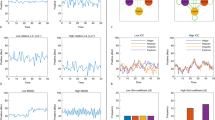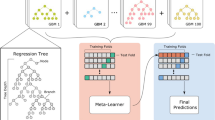Abstract
In contemporary psychological assessments, diverse traits are often evaluated using extensive questionnaires. This study focuses on the trait of emotional stability, and acknowledges the inherent limitations and issues associated with prolonged survey instruments. To address these challenges, we propose a Machine Learning (ML) approach to directly predict emotional stability, offering a more efficient alternative to bulky questionnaires. The study carefully selected variables with previously established relationships to emotional stability, utilizing a dataset of 2203 individuals who responded to a series of psychometric questionnaires. The proposed method yields promising results, achieving an R2 score of approximately 0.71 on the test set, indicating robust predictive performance. These models highlighted the significance of variables such as emotional stress and self-esteem, emphasizing their substantial role in predicting emotional stability. It is noteworthy that even with a reduced set of variables, the models remained statistically equivalent. The results provide valuable insights for predicting stability with smaller sets of variables and contribute knowledge that complements the understanding of emotional stability.




Similar content being viewed by others
Explore related subjects
Discover the latest articles, news and stories from top researchers in related subjects.Data availability
Data available upon request to the corresponding author.
Abbreviations
- BR:
-
Bayesian Ridge
- DT:
-
Decision Tree
- GB:
-
Gradient Boosting
- k-NN:
-
K-Nearest Neighbour
- LR:
-
Linear Regression
- MLP:
-
Multi-Layer Perceptron
- MSE:
-
Mean Squared Error
- R 2 :
-
R-squared
- RF:
-
Random Forest
- SVR:
-
Support Vector Regression
References
Alessandri G, Perinelli E, De Longis E, Schaufeli WB, Theodorou A, Borgogni L, ..., Cinque L (2018) Job burnout: The contribution of emotional stability and emotional self‐efficacy beliefs. J Occup Organ Psychol 91(4):823–851
Atienza FL, Pons D, Balaguer I, García-Merita M (2000) Propiedades psicométricas de la Escala de Satisfacción con la Vida en adolescentes. Psicothema 12(2):314–319
Azen R, Budescu DV (2006) Comparing predictors in multivariate regression models: An extension of dominance analysis. J Educ Behav Stat 31(2):157–180
Baessler J, Scharzer R (1993) Spanish adaptation of the general self-efficacy scale. Ansiedad y Estrés 2(1):1–8
Bai R, Xiao L, Guo Y, Zhu X, Li N, Wang Y, ..., Yu X (2021) Tracking and monitoring mood stability of patients with major depressive disorder by machine learning models using passive digital data: prospective naturalistic multicenter study. JMIR mHealth uHealth 9(3):e24365
Bajaj B, Gupta R, Sengupta S (2019) Emotional stability and self-esteem as mediators between mindfulness and happiness. J Happiness Stud 20:2211–2226
Bandura A (1977) Self-efficacy: toward a unifying theory of behavioral change. Psychol Rev 84(2):191
Bandura A (1992) Social cognitive theory of social referencing. In Social referencing and the social construction of reality in infancy (pp. 175–208). Springer. https://doi.org/10.1007/978-1-4899-2462-9_8
Barrios-Choplin R, Atkinson M (2004) Personal and organizational quality assessment–revised 4 scale (52 questions). Boulder Creek: Institute of HeartMath. Retrieved February 16, 2017
Biswas-Diener R (2008) The new (smiley) face of economics [Review of the book Happiness: A revolution in economics, by B. S. Frey]. PsycCRITIQUES 53(47). https://doi.org/10.1037/a0014204
Breiman L (2001) Random forests. Mach Learn 45:5–32
Buchanan TM, Reilly PM (2019) The impact of HeartMath resiliency training on health care providers. Dimens Crit Care Nurs 38(6):328–336
Caprara G, Vecchione M, Barbaranelli C, Alessandri G (2013) Emotional stability and affective self–regulatory efficacy beliefs: Proofs of integration between trait theory and social cognitive theory. Eur J Pers 27(2):145–154
Cohrdes C, Mauz E (2020) Self-efficacy and emotional stability buffer negative effects of adverse childhood experiences on young adult health-related quality of life. J Adolesc Health 67(1):93–100
Costa PT Jr, McCrae RR (1995) Domains and facets: Hierarchical personality assessment using the Revised NEO Personality Inventory. J Pers Assess 64(1):21–50
Costa PT, McCrae RR (1980) Influence of extraversion and neuroticism on subjective well-being: happy and unhappy people. J Pers Soc Psychol 38(4):668
Crowe ML, LoPilato AC, Campbell WK, Miller JD (2016) Identifying two groups of entitled individuals: Cluster analysis reveals emotional stability and self-esteem distinction. J Pers Disord 30(6):762–775
Csikszentmihalyi M (2014) Flow and the foundations of positive psychology: The collected works of Mihaly Csikszentmihalyi. Springer Dordrecht. https://doi.org/10.1007/978-94-017-9088-8
Chen Y, Liu Y (2021) Which risk factors matter more for psychological distress during the covid-19 pandemic? An application approach of gradient boosting decision trees. Int J Environ Res Public Health 18(11):5879
Chowdhury B, Das N (2022) Predictive analysis of child’s mental health/psychology during the COVID-19 pandemic. Comput Intell Pattern Recog: Proc CIPR 2022(480):183
Diener E, Emmons RA, Larsen RJ, Griffin S (1985) The satisfaction with life scale. J Pers Assess 49(1):71–75
Diener E, Wirtz D, Tov W, Kim-Prieto C, Choi D-W, Oishi S, Biswas-Diener R (2010) New well-being measures: Short scales to assess flourishing and positive and negative feelings. Soc Indic Res 97:143–156
Extremera N, Fernández-Berrocal P (2004) La importancia de desarrollar la inteligencia emocional en el profesorado. Rev Iberoam Educ 34(3):1–9
Farahani H, Azadfallah P, Rahiminezhad A (2020) Comparison of Logistic Regression (LR), Fuzzy Rule-Based Classification (FRBC), and Multilayer Perceptron (MLP) Classifier using Anxiety Data. In Proceedings of the 9th European Congress of Methodology, Valencia
Fernández-Berrocal P, Extremera N, Ramos N (2004) Validity and reliability of the Spanish modified version of the Trait Meta-Mood Scale. Psychol Rep 94(3):751–755
Frye CM (2000) The effect of emotional stability on job satisfaction: a meta-analysis. The University of Iowa. ProQuest Dissertations & Theses. (Publication No. 9996092)
Getzels JW, Csikszentmihalyi M (1976) The creative vision: a longitudinal study of problem finding in art. Wiley. A Wiley-Interscience publication. CRID: 1130282273332109440
Godoy-Izquierdo D, Vélez M, Rodríguez Z, Jiménez M, APDA (2009) Flow en el deporte: concepto, evaluación y hallazgos empíricos. In Libro de abstracts del XII Congreso Andaluz de Psicología de la Actividad Física y el Deporte. Jaén, APDA
Hastie T, Friedman J, Tibshirani R (2001) The elements of statistical learning: data mining, inference, and prediction, 1st ed. Springer, New York. https://doi.org/10.1007/978-0-387-21606-5
Henninger M, Debelak R, Rothacher Y, Strobl C (2023) Interpretable machine learning for psychological research: Opportunities and pitfalls. Psychological Methods. Advance online publication. https://doi.org/10.1037/met0000560
Hills P, Argyle M (2001) Emotional stability as a major dimension of happiness. Personal Individ Differ 31(8):1357–1364
Jackson SA, Eklund RC (2004) The flow scales manual. Fitness Information Technology. Morgantown
Kaiser RT, Ozer DJ (1997) Emotional stability and goal-related stress. Personal Individ Differ 22(3):371–379
Kjell ON, Diener E (2021) Abbreviated three-item versions of the satisfaction with life scale and the harmony in life scale yield as strong psychometric properties as the original scales. J Pers Assess 103(2):183–194
Kobylińska D, Zajenkowski M, Lewczuk K et al (2022) The mediational role of emotion regulation in the relationship between personality and subjective well-being. Curr Psychol 41:4098–4111. https://doi.org/10.1007/s12144-020-00861-7
Koffi BJB (2020) Inferring Big Five personality factors using text analysis: Its assessment and impact on prosocial behavior and IS security compliance. The University of Texas at Arlington. ProQuest Dissertations & Theses. (Publication No. 28068856)
Martín-Albo J, Núñez JL, Navarro JG, Grijalvo F (2007) The Rosenberg Self-Esteem Scale: translation and validation in university students. Span J Psychol 10(2):458–467
Maydeu-Olivares A, Shi D, Fairchild AJ (2020) Estimating causal effects in linear regression models with observational data: The instrumental variables regression model. Psychol Methods 25(2):243
Namazkhan M, Albers C, Steg L (2020) A decision tree method for explaining household gas consumption: The role of building characteristics, socio-demographic variables, psychological factors and household behaviour. Renew Sustain Energy Rev 119:109542
Olaru G, van Scheppingen MA, Bleidorn W, Denissen JJA (2023) The link between personality, global, and domain-specific satisfaction across the adult lifespan. J Pers Soc Psychol 125(3):590–606. https://doi.org/10.1037/pspp0000461
Omoregie J, Carson J (2023) Reductive mechanisms for unwanted intrusive thoughts: exploring affectivity in clinical and non-clinical samples. Ment Health Soc Incl 27(1):51–65
Orrù G, Monaro M, Conversano C, Gemignani A, Sartori G (2020) Machine learning in psychometrics and psychological research. Front Psychol 10:2970
Pegalajar M, Ruiz L, Pérez-Moreiras E, Boada-Grau J, Serrano-Fernandez M (2023) An intelligent approach using machine learning techniques to predict flow in people. Big Data Cogn Comput 7(2):67
Peiqing H (2022) Multidimensional state data reduction and evaluation of college students’ mental health based on SVM. J Math 2022:1–11
Pérez-Moreiras E (2020) La inteligencia y el coaching energéticos: Una aproximación basada en la evidencia desde la psicología para el desarrollo de la inteligencia energética (Energetic Intelligence), el fluir (Flow) y el florecer (Flourishing). Universitat Rovira i Virgili
Philipp M, Rusch T, Hornik K, Strobl C (2018) Measuring the stability of results from supervised statistical learning. J Comput Graph Stat 27(4):685–700
Rietschel L, Zhu G, Kirschbaum C, Strohmaier J, Wüst S, Rietschel M, Martin NG (2014) Perceived stress has genetic influences distinct from neuroticism and depression. Behav Genet 44:639–645
Rosenberg M (1965) Rosenberg self-esteem scale (RSE). Acceptance and commitment therapy. Measures package 61(52):18
Rosenberg M (2015) Society and the adolescent self-image. Princeton university press. https://doi.org/10.1515/9781400876136
Sanjuán P, Pérez A, Bermúdez J (2000) Escala de Autoeficacia General: Datos psicométricos de la adaptación para población Española [The General Self-efficacy Scale: Psychometric data from the Spanish adaptation]. Psicothema 12(supl. 2):509–513
Schippers MC, Hogenes R (2011) Energy management of people in organizations: A review and research agenda. J Bus Psychol 26(2):193–203
Serrano-Fernández MJ, Pérez-Moreiras E, Boada-Cuerva M, Assens-Serra J, Boada-Grau J (in press) Personality, self-efficacy and self-esteem as predictors of psychological well-being of workers: the flourishing scale (5-FS). Int J Bus Environ https://doi.org/10.1504/IJBE.2023.10058504
Şevgin H, Eranıl AK (2023) Investigation of Turkish Students’ School Engagement through Random Forest Methods Applied to TIMSS 2019: A Problem of School Psychology. Int J Psychol Educ Stud 10(4):896–909
Stuke H, Priebe K, Weilnhammer VA, Stuke H, Schoofs N (2023) Sparse models for predicting psychosocial impairments in patients with PTSD: An empirical Bayes approach. Psychol Trauma Theory Res Pract Policy 15(1):80
Tewfik BA, Kim D, Patil SV (2024) The ebb and flow of job engagement: Engagement variability and emotional stability as interactive predictors of job performance. J Appl Psychol 109(2):257–282. https://doi.org/10.1037/apl0001129
Vigil-Colet A, Morales-Vives F, Camps E, Tous J, Lorenzo-Seva U (2013) Desarrollo y validacion de las Escalas de Evaluacion Global de la Personalidad (OPERAS). Psicothema 25(1):100–107
Wardenaar KJ, Riese H, Giltay EJ, Eikelenboom M, van Hemert AJ, Beekman AF, ..., Schoevers RA (2021) Common and specific determinants of 9-year depression and anxiety course-trajectories: A machine-learning investigation in the Netherlands Study of Depression and Anxiety (NESDA). J Affect Disord 293:295–304
Yuan C, Wu J, Li H, Wang L (2018) Personality recognition based on user generated content. 2018 15th International Conference on Service Systems and Service Management (ICSSSM). https://doi.org/10.1109/ICSSSM.2018.8465006
Acknowledgements
The authors extend their heartfelt gratitude to RH Asesores Improving, Talent Development Institute for its invaluable contributions and support throughout the research process. Furthermore, we wish to emphasize that this research was undertaken without specific funding, and the authors conducted and concluded the study independently.
Author information
Authors and Affiliations
Contributions
All authors have contributed equally to this work.
Corresponding author
Ethics declarations
Ethical and informed consent for data used
Ethical approval and informed consent were obtained for all data used in this study.
Competing interests
The authors declare that there is no conflict of interest.
Additional information
Publisher's Note
Springer Nature remains neutral with regard to jurisdictional claims in published maps and institutional affiliations.
Rights and permissions
Springer Nature or its licensor (e.g. a society or other partner) holds exclusive rights to this article under a publishing agreement with the author(s) or other rightsholder(s); author self-archiving of the accepted manuscript version of this article is solely governed by the terms of such publishing agreement and applicable law.
About this article
Cite this article
Madroñal, M.R., Ramírez, E.S., Ruiz, L.G.B. et al. Exploring emotional stability: from conventional approaches to machine learning insights. Appl Intell 55, 213 (2025). https://doi.org/10.1007/s10489-024-06130-5
Accepted:
Published:
DOI: https://doi.org/10.1007/s10489-024-06130-5




